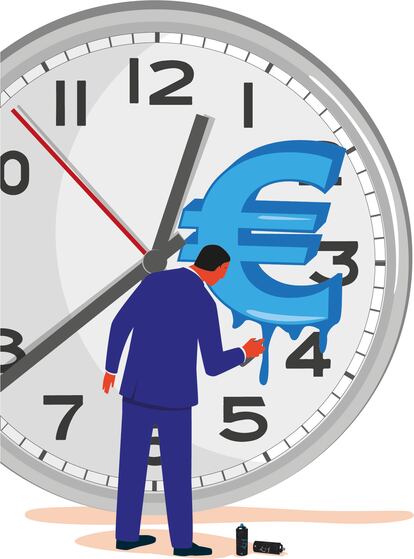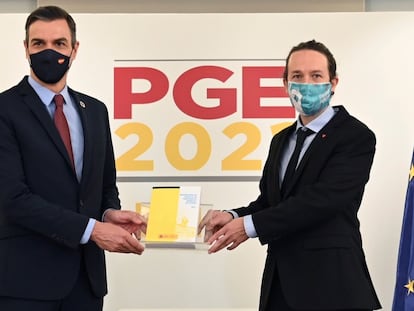The euro’s moment
The single currency is stuck in its international role while the dollar maintains its supremacy

Frankfurt’s square with the euro symbol, next to the former main European Central Bank (ECB) building on Kaiserstrasse, has lost its shine with the ECB’s move to its brand new headquarters on the banks of the Main river. The euro symbol lights up at night what is now a meeting place for skateboarders, travelers waiting for the last bus, and wandering couples.
This lost shine is a good metaphor for the euro’s evolution. More than 20 years since its creation, it has struggled to establish itself as a true reserve currency that can overshadow the dollar. The eurozone has faltered, with weak and fragile growth over the last decade, growing internal economic divergences, inflation well below target, and deep unresolved structural deficiencies. It is not surprising, therefore, that countries no longer see the adoption of the euro (which, lest we forget, is a commitment by all the EU member states) as an incentive to change and improve their economic policies. The euro’s soft power, that diplomatic ability to encourage political changes in exchange for a better economic future, has been dampened, in parallel with the deterioration of the EU’s ability to contain political drifts not only in its neighborhood but even within its borders, as shown by the evolution of Turkey, Poland and Hungary towards illiberal democracy.
On the global stage, the euro punches well below its weight. The US and the eurozone account for a similar percentage of global GDP and trade but, according to International Monetary Fund (IMF) data, the percentage of global reserves denominated in euros is only 20 percent, well below the dollar’s 60 percent. The ECB’s index of the international role of the euro, which also includes the euro’s use as a currency for the denomination of assets and as an international means of payment, shows a similar share.
The dollar’s supremacy allows the US to enjoy the so-called “exorbitant privilege”, the US' ability to finance itself at lower interest rates than would correspond to its macroeconomic fundamentals. It also allows the US to exert strong and decisive diplomatic pressure at the global level, through the control of the dollar payment system and the application of sanctions, something that, too many times already, has placed Europe in a delicate diplomatic situation that might have been avoided were the euro a true alternative to the dollar.
Priority objective
Strengthening the international role of the euro must be a priority for eurozone governments, both for economic and geopolitical reasons. The US has been devoting much more attention and resources to Asia than to Europe for a long time: the sad reality is that, in Washington, Europe has become rarely relevant outside crisis periods, and the assertiveness, power and effectiveness of China’s economic diplomacy is evident. Europe can no longer hide behind the Atlantic Alliance, it must find its own voice, stop being the playing field of international relations, and become a decisive player. But for this, good intentions, declarations of principles, or marginal measures are not enough. If Europe wants to increase its geostrategic potential it must offer more than just the European way of life, it must invest in the euro.
The key to the dollar’s exorbitant privilege is the large and liquid US Treasury bond market, which provides a credible and safe asset for global investors. If the eurozone wants to enhance the international role of the euro, the necessary condition is to move in two directions, in the short and medium term.
In the short term, adapt the Stability Pact to the post-Covid19 reality accepting that, when interest rates are zero, public debt is not an objective but an instrument of economic policy, and therefore eliminating the objective of reducing at all costs the debt/GDP ratio of 60%. It is an essential step to boost the eurozone’s growth and avoid a premature tightening of fiscal policy and an increase in economic divergence both internally and with the US and China.
In the medium term, strengthen the common fiscal policy and its necessary issuance of Eurobonds; not synthetic assets, but real Eurobonds. Global demand exists: a couple of weeks ago, the EU began issuing the “social bonds” that will finance the SURE program to support the labor market, and they were 14 times oversubscribed. The European Recovery Plan should be the seed of the Eurobonds and of the European safe asset. To flourish, it must become a permanent instrument, with a bigger size and the necessary European taxes to service the debt. In addition to creating a reserve asset, it is an instrument to reverse the collapse of public investment, complete the economic architecture of the euro, and permanently underpin the stability of the eurozone. This year’s experience is sufficient evidence that sharing risks with a common fiscal policy makes the eurozone more stable.
The Covid-19 crisis is the moment of truth for the euro. To paraphrase Paolo Giordano, if this opportunity is wasted, the dollar and the euro will remain like twin primes, those that are separated by a non-prime number: close enough to be comparable, but always far enough away to never be the same.
Tu suscripción se está usando en otro dispositivo
¿Quieres añadir otro usuario a tu suscripción?
Si continúas leyendo en este dispositivo, no se podrá leer en el otro.
FlechaTu suscripción se está usando en otro dispositivo y solo puedes acceder a EL PAÍS desde un dispositivo a la vez.
Si quieres compartir tu cuenta, cambia tu suscripción a la modalidad Premium, así podrás añadir otro usuario. Cada uno accederá con su propia cuenta de email, lo que os permitirá personalizar vuestra experiencia en EL PAÍS.
¿Tienes una suscripción de empresa? Accede aquí para contratar más cuentas.
En el caso de no saber quién está usando tu cuenta, te recomendamos cambiar tu contraseña aquí.
Si decides continuar compartiendo tu cuenta, este mensaje se mostrará en tu dispositivo y en el de la otra persona que está usando tu cuenta de forma indefinida, afectando a tu experiencia de lectura. Puedes consultar aquí los términos y condiciones de la suscripción digital.
More information
Últimas noticias
Raúl Rocha, from jet-setting with Miss Universe to arms trafficking and fuel theft
80,000 barrels of Mexican oil sent to Cuba: Havana drawn into the US–Mexico clash
Human rights activists, opposition members, and a minor: Maduro’s other political prisoners
Israel sparks a civil war within the MAGA movement
Most viewed
- Reinhard Genzel, Nobel laureate in physics: ‘One-minute videos will never give you the truth’
- Pablo Escobar’s hippos: A serious environmental problem, 40 years on
- Charles Dubouloz, mountaineering star, retires at 36 with a farewell tour inspired by Walter Bonatti
- Why we lost the habit of sleeping in two segments and how that changed our sense of time
- The fall of a prolific science journal exposes the billion-dollar profits of scientific publishing











































